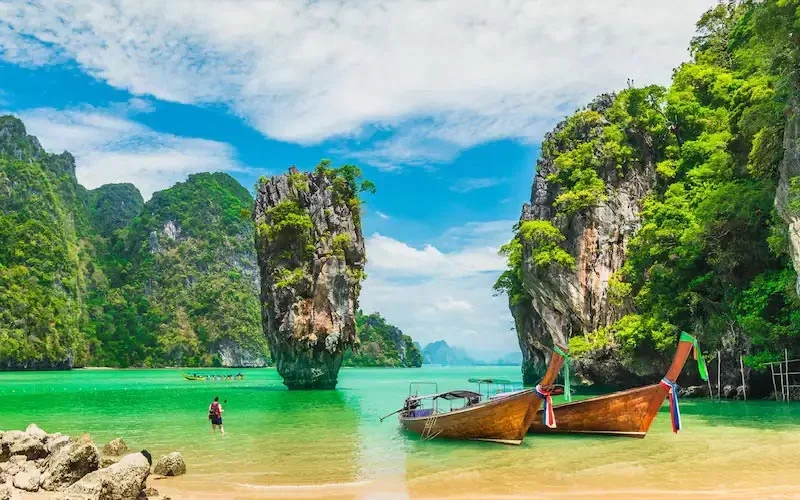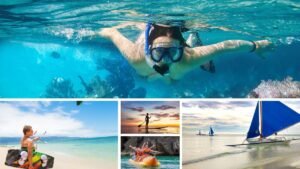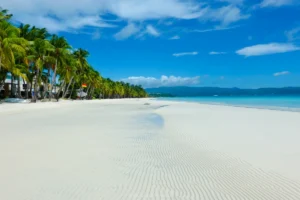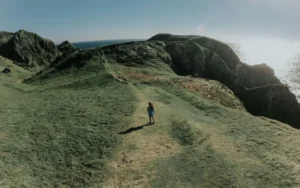Introduction to Phang Nga Bay
Located in the southern region of Thailand, Phang Nga Bay stands as one of the most visually striking destinations, capturing the essence of natural and architectural grandeur. Encompassing over 40 islands, this enchanting bay is renowned for its awe-inspiring limestone karsts that dramatically emerge from the emerald-green waters, creating a unique landscape that beckons photographers and tourists from around the globe.
Phang Nga Bay is not just a haven of natural beauty but also a site rich in historical significance. Historically, the bay has served as a strategic location for trade and maritime activities. Ancient communities settled around its waters, leaving behind a legacy interwoven with intriguing folklore and spiritual relevance. The bay’s diverse cultural tapestry is reflected in its temples, caves, and ancient rock paintings, offering a glimpse into Thailand’s storied past.
Tourists flock to Phang Nga Bay not only to soak in its natural wonders but also to marvel at its architectural beauty. Among the highlights is the James Bond Island, officially known as Khao Phing Kan, which gained international fame after featuring in the 1974 James Bond film, “The Man with the Golden Gun.” This iconic site, along with the dramatic cliffs and hidden lagoons, provides unparalleled opportunities for capturing stunning photographs.
Complementing its mesmerizing geological formations, Phang Nga Bay’s floating Muslim village, Koh Panyee, exemplifies human ingenuity and resilience. Built on stilts over the water, this unique settlement boasts colorful homes, a school, and a mosque, all seemingly afloat, creating a rare architectural marvel that attracts both curious eyes and camera lenses.
The allure of Phang Nga Bay lies in its harmonious blend of natural splendor and man-made wonders, making it an essential destination for anyone seeking to capture the essence of Thailand’s picturesque charm and rich cultural tapestry. Whether you’re an avid photographer, a history enthusiast, or a nature lover, Phang Nga Bay promises a kaleidoscope of experiences that epitomize the region’s serene magnificence.
Architectural Marvels of Phang Nga Bay
Phang Nga Bay is a sanctuary of both natural and human-made architectural treasures. The bay is renowned for its limestone karsts, which rise majestically from the emerald green waters, offering a stunning visual experience. These karsts have been sculpted over millennia by geological processes, resulting in dramatic cliffs, hidden inlets, and intricate cave systems that captivate visitors and photographers alike.
Among the natural wonders, the sea caves, known locally as “hongs,” present a unique architectural allure. Accessible only via kayaks or small boats, these hongs offer an otherworldly experience with their enclosed lagoons and towering rock formations. The interplay of light and shadow within these caves makes them a paradise for photographers seeking to capture the essence of Phang Nga Bay’s beauty.
In addition to these natural formations, Phang Nga Bay boasts a rich tapestry of human influence. Among these is the ancient rock art found on various cliff faces and cave walls. These artworks provide a glimpse into the historical and cultural narratives of the region, adding an anthropological dimension to the bay’s visual appeal. The art typically consists of motifs and figures that date back thousands of years, establishing a profound connection between the past and the present.
The iconic James Bond Island, officially known as Khao Phing Kan, stands as one of the most famous landmarks in the bay. Named after its appearance in the James Bond film “The Man with the Golden Gun,” this island has become a symbol of Phang Nga Bay’s picturesque beauty. The island’s distinctive shape and towering limestone pillar, coupled with the serene surrounding waters, make it a must-visit for photographers looking to capture iconic shots.
The blend of these natural limestone karsts, sea caves, ancient rock art, and the globally recognized James Bond Island serves to create an unparalleled visual experience. Whether viewed from a boat, a secluded beach, or through the lens of a camera, the architectural marvels of Phang Nga Bay stand as a testament to the awe-inspiring symbiosis of nature and history. These elements collectively contribute to the bay’s unique aesthetic appeal, making it not only a feast for the eyes but also a treasure trove for any photographer seeking to capture nature’s grandeur.
Essential Photography Tips
Capturing the essence of Phang Nga Bay requires more than just a keen eye; it demands strategic planning and an understanding of the bay’s unique environment. Photography enthusiasts will find that early mornings and late afternoons offer the best lighting conditions. The golden hour, occurring shortly after sunrise and before sunset, bathes the bay in a warm, soft light that enhances the textures and colors of the iconic limestone karsts and turquoise waters.
Regarding camera settings, shooting in RAW format is recommended to retain the highest quality and flexibility in post-processing. Using a low ISO setting, generally between 100 and 200, helps to maintain image clarity while reducing noise. Aperture settings ranging from f/8 to f/11 are ideal for capturing the expansive landscapes of Phang Nga Bay, ensuring sufficient depth of field. A tripod can be instrumental in achieving sharp images, particularly in low-light conditions.
Weather plays a pivotal role in determining the quality of your photographs. Clear, sunny days with minimal cloud cover provide vibrant, high-contrast scenes, perfect for wide-angle shots. Conversely, overcast or stormy weather can offer dramatic skies and diffused lighting, ideal for highlighting the moody and mystical aspects of the bay’s geological formations. It is essential to monitor weather forecasts and be prepared for sudden changes, ensuring you have appropriate gear to protect your equipment.
The advent of drone technology has revolutionized landscape photography, offering unprecedented perspectives of Phang Nga Bay. Drones allow photographers to capture stunning aerial views, showcasing the bay’s intricate network of islands and cliffs. When using a drone, be mindful of local regulations and the natural habitat to avoid disturbing wildlife or other visitors.
Finally, do not overlook the smaller details. The unique rock formations, lush vegetation, and hidden caves within Phang Nga Bay provide ample opportunities for capturing intricate textures and patterns. Combining wide-angle shots with close-up details creates a comprehensive visual story, reflecting the multifaceted beauty of this remarkable destination.
Top Photography Spots in Phang Nga Bay
Phang Nga Bay is a photographer’s paradise, replete with dramatic limestone cliffs, tranquil waters, and hidden caves. One of the most iconic spots is James Bond Island, officially known as Khao Phing Kan. This site, made famous by the James Bond film “The Man with the Golden Gun,” offers stunning vistas with its towering limestone karsts emerging from the emerald-green waters. The island’s unique geological formations provide photographers with a multitude of angles, where the interplay of light and shadow brings the scenery to life.
Another must-visit location is Koh Panyee, a floating village that captivates with its stilted wooden houses and the striking backdrop of massive cliffs. The vibrant life of the local fishing community alongside the picturesque, ramshackle structures presents endless opportunities for capturing cultural and landscape shots. The hustle and bustle of this floating village, with its markets, schools, and even a floating football field, allow photographers to narrate rich, visual stories.
The caves of Tham Lod and Tham Lek in Phang Nga Bay offer equally remarkable photography experiences. Tham Lod is renowned for its awe-inspiring sea cave, where sunlight filtering through the water illuminates the cavern’s submerged sections, creating a fantastic play of light and reflection. This location is perfect for capturing ethereal, almost mystical images.
Tham Lek, slightly less known but no less spectacular, is distinguished by its ancient rock formations and petroglyphs. These caves offer an intriguing glimpse into the prehistoric era, with the intricate carvings and natural sculptures providing compelling subjects for photography. The intricate texture and shadow work inside these caves contribute to creating profoundly atmospheric and detailed shots.
Phang Nga Bay’s diverse range of photography spots, each with its unique features, provides an unparalleled canvas for both amateur and professional photographers. The region’s blend of natural beauty, cultural richness, and historical depth ensures that every shot captures a different aspect of its multifaceted allure.
Phang Nga Bay, renowned for its stunning limestone karsts and tranquil waters, is a paradise for photographers. Numerous organized tours and excursions are available, catering to photography enthusiasts eager to capture the bay’s ethereal landscapes. These tours come in various forms, each offering a unique perspective of this extraordinary region.
Boat rides are among the most popular options. Traditional longtail boats or modern speedboats provide access to hidden coves and secluded islands. These excursions often include stops at iconic spots like James Bond Island and Kho Panyi, giving photographers ample opportunities to capture the dramatic cliffs and emerald green waters that define Phang Nga Bay. Guides on these tours are usually well-versed in the best angles and lighting conditions, offering invaluable advice to enhance one’s photography skills.
For those seeking a more intimate experience, kayaking tours meander through the bay’s labyrinth of mangroves and sea caves. Kayakers can glide through narrow passages inaccessible to larger vessels, presenting unique, close-up shots of the natural surroundings. These tours are often led by knowledgeable guides who provide insight into not only the best photographic spots but also the ecological and geological significance of the area.
Hiking expeditions offer yet another way to explore and photograph Phang Nga Bay. Trails leading to elevated viewpoints provide panoramic vistas of the bay’s striking limestone formations. Organized hiking tours often include briefings on local flora and fauna, enriching the photographic experience with context and background. These treks, usually moderate in difficulty, ensure that photographers of all levels can participate and capture breathtaking images.
Special photography workshops and events are also frequently hosted in Phang Nga Bay, offering more structured opportunities to refine photography skills. These workshops might focus on specific aspects such as landscape photography, post-processing techniques, or even night photography to capture the bay under a star-filled sky. Led by professional photographers, these events offer a blend of theoretical instruction and practical, hands-on experience.
Cultural Aspects and Local Life
Nestled in the heart of the Andaman Sea, Phang Nga Bay is not only known for its stunning limestone karsts and emerald waters but also for its rich cultural tapestry. Amidst the natural grandeur, the bay’s local communities offer a glimpse into a way of life that has been preserved for generations. Photographers will find an abundance of subjects here, from traditional fishing practices to colorful markets that paint a vivid picture of daily life.
One of the most compelling aspects of Phang Nga Bay is its traditional fishing villages. These communities, such as the iconic Koh Panyee, are living testaments to a maritime heritage. Built on stilts over the water, these villages provide a unique backdrop for capturing the essence of coastal living. Fishermen can often be seen mending nets or preparing their boats, their weathered faces telling stories of the sea. The traditional long-tail boats themselves are photogenic subjects, their vibrant hues standing out against the tranquil waters.
Local markets in Phang Nga Bay offer another fantastic opportunity for photography. These bustling hubs are brimming with fresh produce, seafood, and handcrafted goods. The interplay of colors, textures, and the animated interactions among vendors and buyers create dynamic scenes that can capture the spirit of the locale. Early mornings are particularly promising times for photography, as the markets come to life with the energy and urgency of daily trade.
Festivals and celebrations are frequent in this region, presenting further avenues for capturing the cultural essence. Events such as the Loy Krathong festival, where people float decorated baskets on water, and various temple fairs provide a candid look into local traditions and communal life. The vibrant costumes, intricate decorations, and the joy on people’s faces are moments waiting to be immortalized through the lens.
Beyond the organized activities, everyday life in Phang Nga Bay holds a charm of its own. Children playing on the beaches, elders sharing stories, and artisans at work represent the continuity of life and culture in this beautiful bay. For photographers, these moments are invaluable in narrating the story of Phang Nga Bay, showcasing not just its scenic beauty but the heart and soul of its people.
Phang Nga Bay, renowned for its stunning limestone karsts and pristine waters, has become a focal point for environmental conservation efforts aimed at preserving its unique natural beauty and delicate ecosystems. As tourism in Phang Nga Bay grows, so does the responsibility to protect its fragile environment from the adverse impacts of human activity. Key conservation initiatives currently include strict regulations on waste disposal, marine protected areas, and reef restoration projects, all aimed at safeguarding the bay’s diverse marine life and iconic landscapes.
Responsible tourism is paramount in ensuring the sustainability of Phang Nga Bay. Tourists, including photographers, can play a significant role in conservation by adhering to established guidelines and respecting the local environment. This includes practices such as minimizing plastic use, properly disposing of waste, and avoiding activities that could damage coral reefs and marine habitats. Moreover, visitors are encouraged to use environmentally-friendly modes of transportation, such as kayaks or long-tail boats operated by local communities, which not only reduce pollution but also support the local economy.
Photographers, in particular, have a unique opportunity to contribute to conservation efforts. By capturing and sharing images of Phang Nga Bay’s natural splendor, they can raise awareness about the importance of preserving its ecosystems. However, photographers should also be mindful of their environmental footprint. Simple actions, such as staying on designated trails, using biodegradable products, and refraining from disturbing wildlife, can make a substantial difference. Supporting local conservation initiatives, either through donations or participation in volunteer programs, further aids in the protection of this treasured landscape.
Preserving Phang Nga Bay’s architectural beauty and biological diversity requires collective effort from both locals and visitors. By practicing responsible tourism and supporting conservation endeavors, we can ensure that the awe-inspiring majesty of Phang Nga Bay remains a source of inspiration for generations to come.
Final Thoughts and Personal Experiences
Visiting Phang Nga Bay is a journey that transcends the ordinary. As a photographer, capturing the essence of this unique location is both a challenge and a reward. My favorite moments were often the quiet ones—those instances when the early morning mist drifted lazily over the limestone cliffs, painting the landscape in hues of grey and blue. It is during these calm moments that Phang Nga Bay’s true character reveals itself, offering unparalleled opportunities for an evocative shot.
I vividly remember a particular sunrise at Koh Tapu, popularly known as James Bond Island. The way the first light of dawn caressed the jagged edges of the rock formations, casting elongated shadows over the tranquil waters, was a sight to behold. Each click of my shutter felt like an ode to the timeless beauty of the bay. It’s these kinds of experiences that make Phang Nga Bay so much more than a mere destination—it becomes a canvas where nature and imagination collaborate in perfect harmony.
Not to be overlooked are the charming local villages and their stilted houses precariously hugging the edges of the cliffs. Documenting the daily life of these resilient communities adds a human element to the idyllic scenery. One of my most cherished photos is of a local fisherman casting his net at dusk, the waning light reflecting off the water providing a dramatic backdrop.
For those considering a visit, I highly encourage respecting the natural and cultural beauty of the area. Phang Nga Bay is not just a feast for the eyes but a delicate ecosystem that thrives on our conscientiousness. Leave no trace behind, take only photographs, and cherish every moment spent in this wondrous location. Phang Nga Bay offers an irreplaceable experience, filled with rich memories waiting to be captured through your lens.







